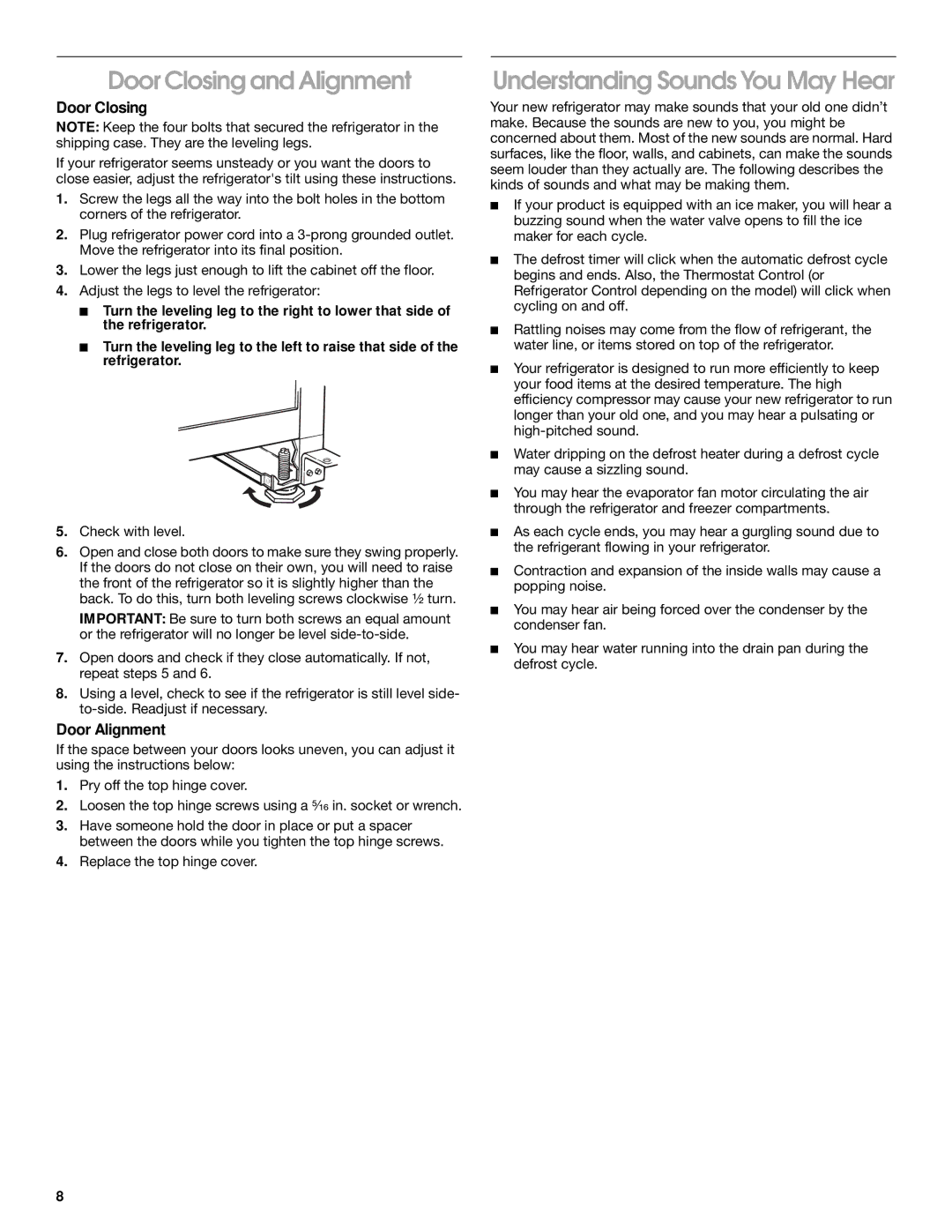
Door Closing and Alignment
Door Closing
NOTE: Keep the four bolts that secured the refrigerator in the shipping case. They are the leveling legs.
If your refrigerator seems unsteady or you want the doors to close easier, adjust the refrigerator's tilt using these instructions.
1.Screw the legs all the way into the bolt holes in the bottom corners of the refrigerator.
2.Plug refrigerator power cord into a
3.Lower the legs just enough to lift the cabinet off the floor.
4.Adjust the legs to level the refrigerator:
■Turn the leveling leg to the right to lower that side of the refrigerator.
■Turn the leveling leg to the left to raise that side of the refrigerator.
5.Check with level.
6.Open and close both doors to make sure they swing properly. If the doors do not close on their own, you will need to raise the front of the refrigerator so it is slightly higher than the back. To do this, turn both leveling screws clockwise ¹⁄₂ turn.
IMPORTANT: Be sure to turn both screws an equal amount or the refrigerator will no longer be level
7.Open doors and check if they close automatically. If not, repeat steps 5 and 6.
8.Using a level, check to see if the refrigerator is still level side-
Door Alignment
If the space between your doors looks uneven, you can adjust it using the instructions below:
1.Pry off the top hinge cover.
2.Loosen the top hinge screws using a ⁵⁄₁₆ in. socket or wrench.
3.Have someone hold the door in place or put a spacer between the doors while you tighten the top hinge screws.
4.Replace the top hinge cover.
Understanding Sounds You May Hear
Your new refrigerator may make sounds that your old one didn’t make. Because the sounds are new to you, you might be concerned about them. Most of the new sounds are normal. Hard surfaces, like the floor, walls, and cabinets, can make the sounds seem louder than they actually are. The following describes the kinds of sounds and what may be making them.
■If your product is equipped with an ice maker, you will hear a buzzing sound when the water valve opens to fill the ice maker for each cycle.
■The defrost timer will click when the automatic defrost cycle begins and ends. Also, the Thermostat Control (or Refrigerator Control depending on the model) will click when cycling on and off.
■Rattling noises may come from the flow of refrigerant, the water line, or items stored on top of the refrigerator.
■Your refrigerator is designed to run more efficiently to keep your food items at the desired temperature. The high efficiency compressor may cause your new refrigerator to run longer than your old one, and you may hear a pulsating or
■Water dripping on the defrost heater during a defrost cycle may cause a sizzling sound.
■You may hear the evaporator fan motor circulating the air through the refrigerator and freezer compartments.
■As each cycle ends, you may hear a gurgling sound due to the refrigerant flowing in your refrigerator.
■Contraction and expansion of the inside walls may cause a popping noise.
■You may hear air being forced over the condenser by the condenser fan.
■You may hear water running into the drain pan during the defrost cycle.
8
